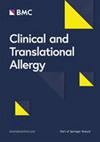Breath of relief: Transforming pediatric asthma care with telemedicine-guided exercises
Abstract
Background
Alternative non-pharmacological strategies such as breathing exercises can be used in combination with pharmacological treatments.
Objective
The aim of this randomized, controlled, single-blind study was to investigate the effectiveness of breathing exercises in asthma patients on respiratory function, symptom control and quality of life.
Methods
We enrolled pediatric asthma patients who were eligible and motivated for the study and randomly assigned them to either the exercise group (EG) or the control group (CG). The CG received a postural exercise program, while the EG received a breathing exercise program. At baseline and after 12 weeks, respiratory function (FEV1-FVC-FEV1/FVC-PEF), symptom control (using asthma control test, asthma control questionnaire, global initiative for asthma symptom control assessment), quality of life (using pediatric asthma quality of life questionnaire), breath-holding test (BHT) and sit-to-stand test (30sSTS) were assessed and compared.
Results
One hundred twelve patients were randomized, and 99 (n = 51 EG, n = 48 CG) completed the 12-week study. Baseline data were also similar in both groups. After 12 weeks, FEV1, Peak expiratory flow (by spirometry and peak flow meter) and BHT were significantly better in EG than in CG (p = 0.01 and p = 0.007 and p = 0.005, respectively). Asthma Control Test and GINA symptom control tool values were also significantly better in both groups.
Discussion
Our participants were children with mild to moderate asthma. We conclude that our results show that breathing exercises can be an effective intervention for children with partially controlled asthma with FEV1,PEF, and BHTs.


 求助内容:
求助内容: 应助结果提醒方式:
应助结果提醒方式:


